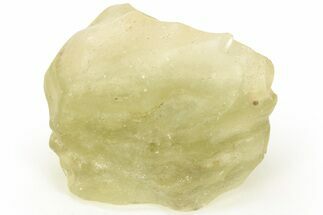This Specimen has been sold.
.55" Libyan Desert Glass (1 gram) - Meteorite Impactite
This is a 1 gram piece of Libyan Desert Glass, a type of meteorite impactite found along the Egyptian and Libyan borders. It measures .55 x .4 x .25".
What Is Libyan Desert Glass
Libyan Desert glass is a type of impactite/tektite formed from the heat and pressure of a meteorite impact. The primary component of this glass is lechatelierite, a molten silica glass similar to quartz but lacking a crystal structure. This desert glass can also be different shades of green, tan, and brown depending on the inclusions present when the glass formed.
Libyan desert glass may have been formed during a meteor shower in the Sahara Desert nearly 29 million years ago. For many years scientists have believed that the impactites were the result of an extremely large airblast, roughly 100 megatons or the equivalent of a nuclear explosion, caused by an explosion in space near Earth’s atmosphere. After extensive analysis, scientists have discovered that Libyan Desert glass is indeed created by meteor impacts.
While geologists have yet to uncover an impact crater, most likely due to erosion under hostile desert conditions, evidence of impact was discovered via good, old-fashioned chemistry. Libyan Desert glass has a very high zircon content: zircon transforms into a different mineral, reidite, when under extreme temperature and pressure, such as is common in a meteor impact. Reidite forms at the moment of impact, but is very unstable and will revert back to zircon when it reaches too high of a temperature. However, when reidite forms it creates a directional shift in its structure that is different from zircon’s. This shift leaves traces of the change, and when zircon is tested with a method called backscatter diffraction, evidence of reidite becomes apparent. The temperature required to initiate this transformation from zircon to reidite and back to zircon could only be achieved by a meteorite impact, and not the pressure wave of an airblast.
Libyan Desert Glass: The Saharan Treasure With Interstellar Origins
Libyan Desert glass is a type of impactite/tektite formed from the heat and pressure of a meteorite impact. The primary component of this glass is lechatelierite, a molten silica glass similar to quartz but lacking a crystal structure. This desert glass can also be different shades of green, tan, and brown depending on the inclusions present when the glass formed.
Libyan desert glass may have been formed during a meteor shower in the Sahara Desert nearly 29 million years ago. For many years scientists have believed that the impactites were the result of an extremely large airblast, roughly 100 megatons or the equivalent of a nuclear explosion, caused by an explosion in space near Earth’s atmosphere. After extensive analysis, scientists have discovered that Libyan Desert glass is indeed created by meteor impacts.
While geologists have yet to uncover an impact crater, most likely due to erosion under hostile desert conditions, evidence of impact was discovered via good, old-fashioned chemistry. Libyan Desert glass has a very high zircon content: zircon transforms into a different mineral, reidite, when under extreme temperature and pressure, such as is common in a meteor impact. Reidite forms at the moment of impact, but is very unstable and will revert back to zircon when it reaches too high of a temperature. However, when reidite forms it creates a directional shift in its structure that is different from zircon’s. This shift leaves traces of the change, and when zircon is tested with a method called backscatter diffraction, evidence of reidite becomes apparent. The temperature required to initiate this transformation from zircon to reidite and back to zircon could only be achieved by a meteorite impact, and not the pressure wave of an airblast.
Libyan Desert Glass: The Saharan Treasure With Interstellar Origins
TYPE
Lechatelierite
AGE
LOCATION
Western Egypt
SIZE
1 grams, .55 x .4 x .25"
CATEGORY
SUB CATEGORY
ITEM
#203623
 Reviews
Reviews













